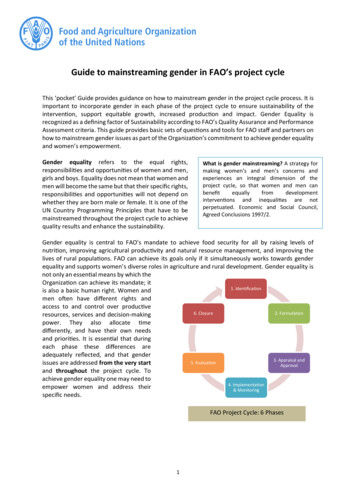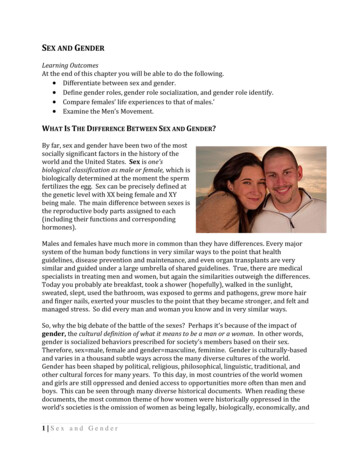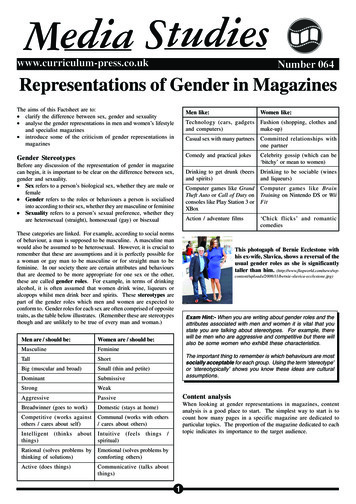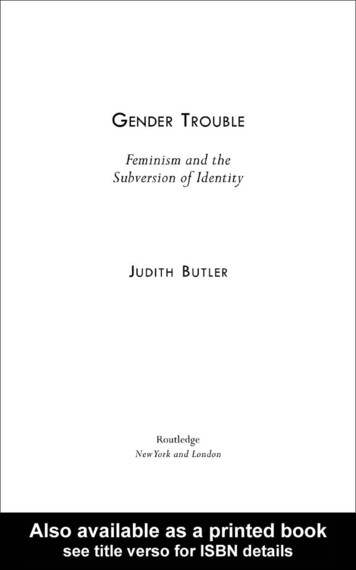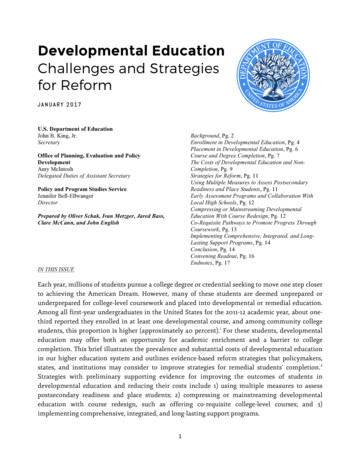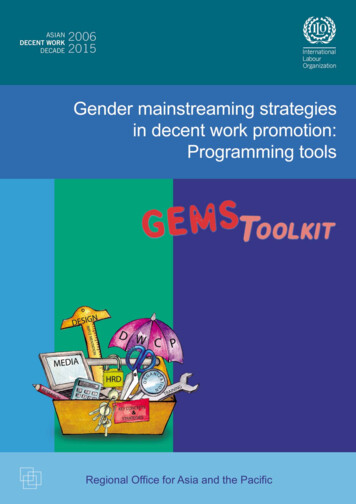
Transcription
iv
Gender mainstreaming strategiesin decent work promotion:Programming toolsRegional Office for Asia and the Pacifici
Copyright International Labour Organization 2010First published 2010Publications of the International Labour Office enjoy copyright under Protocol 2 of the UniversalCopyright Convention. Nevertheless, short excerpts from them may be reproduced withoutauthorization, on condition that the source is indicated. For rights of reproduction or translation,application should be made to ILO Publications (Rights and Permissions), International Labour Office,CH-1211 Geneva 22, Switzerland, or by email: pubdroit@ilo.org. The International Labour Officewelcomes such applications.Libraries, institutions and other users registered with reproduction rights organizations may makecopies in accordance with the licences issued to them for this purpose. Visit www.ifrro.org to find thereproduction rights organization in your country.Gender mainstreaming strategies in decent work promotion: programming tools; GEMS toolkit / ILORegional Office for Asia and the Pacific. – Bangkok: ILO, 2010iii, 87 p.ISBN: 9789221238690; 9789221238706 (web pdf)ILO Regional Office for Asia and the Pacificgender equality / gender mainstreaming / womens empowerment / decent work04.02.3ILO Cataloguing in Publication DataThe designations employed in ILO publications, which are in conformity with United Nations practice,and the presentation of material therein do not imply the expression of any opinion whatsoever on thepart of the International Labour Office concerning the legal status of any country, area or territory or ofits authorities, or concerning the delimitation of its frontiers.The responsibility for opinions expressed in signed articles, studies and other contributions rests solelywith their authors, and publication does not constitute an endorsement by the International LabourOffice of the opinions expressed in them.Reference to names of firms and commercial products and processes does not imply theirendorsement by the International Labour Office, and any failure to mention a particular firm,commercial product or process is not a sign of disapproval.ILO publications and electronic products can be obtained through major booksellers or ILO localoffices in many countries, or direct from ILO Publications, International Labour Office, CH-1211Geneva 22, Switzerland, or ILO Regional Office for Asia and the Pacific, 11th Floor, United NationsBuilding, Rajdamnern Nok Avenue, Bangkok 10200, Thailand, or by email: BANGKOK@ilo.org.Catalogues or lists of new publications are available free of charge from the above address, or byemail: pubvente@ilo.orgVisit our website: www.ilo.org/publnsPrinted in Thailandii
CONTENTSPageAbout the GEMS Toolkit .1Gender Mainstreaming Strategies (GEMS) Tools1. Key concepts and strategies .92. GEMS in Decent Work Country Programmes .223. How to review GEMS in your organization .274. GEMS in research .325. GEMS in project design and implementation .376. GEMS in indicators, monitoring and evaluation .437. Gender budgeting .518. GEMS in human resource management and development .589. GEMS in meetings and training .6210. How to make media products and processes gender-responsive .6711. GEMS in the working environment .7312. Key international labour standards for gender equality in brief .79ANNEXESAnnex 1 Glossary .83Annex 2 ILO standards of specific relevance to gender equality .87iii
iv
About the GEMS ToolkitEquality empowers women and menIt is the RIGHT and the SMART thing to do Why is it the RIGHT thing to do? Too many women and men, girls and boys endurediscrimination, injustice, unfair treatment, and loss of opportunities to advance in life justbecause they have been born female or male. This violates the universal, commonsense of natural justice, and diminishes individuals’ and societies’ chance to fullhappiness, peace and harmony. Every human being has a fundamental right to enjoyequal opportunity and treatment in life and at work. Why is it the SMART thing to do? Countries which let investments in girls’ educationgo to waste and condone discrimination at work, compromise the competitiveness oftheir economies. Gender equality is vital for efficient labour markets. Families,workplaces and societies are more productive and prosperous when they reap the fullpotential and talents of all. It makes good business sense to reward workers on theirmerit rather than their sex, colour or race.1.What is the GEMS Toolkit?The GEMS Toolkit (Gender mainstreaming strategies: Programming tools) is a set of 12practical tools to facilitate the implementation of Gender Mainstreaming Strategies (GEMS) inorganizations, policies, programmes and projects.The GEMS Toolkit aims to share knowledge, skills and tools with ILO constituents andpartners in the Asia-Pacific region and worldwide on how to: do a gender analysis of their work and their organizationput gender in the mainstream of policies, programmes and projectscarry out gender-specific action to redress inequalities.The tools in the GEMS Toolkit have been designed in the form of quick reference guides,checklists and tips for ease of use. The first tool gives an overview of key concepts anddefinitions concerning gender equality and gender mainstreaming strategies in the worldof work. The other GEMS tools are organized by topic, addressing gender concerns in(country) strategy development on decent work, in organizations, research, the design,implementation, monitoring and evaluation of programmes and projects, in budgeting, humanresource development, media products and processes, meetings and training, and in theworking environment. They conclude with a summary of four main international labourstandards for gender equality (see the brief content of each tool in Section 6 below).The Toolkit is available in two formats: a ring binder with the complete set of guides, checklists and tipsa desk calendar, the ‘GEMS Toolkit’ in Brief, with the main gender pointers of each tool.1
2.Who can use it?This GEMS Toolkit is designed for ILO constituents and partner organizations. These include,for example: ministries of labour, human resources, social security, social welfare, interior,planning and finance, women and gender equality, education and training, indigenouspopulations; employers’ and workers’ organizations, non-governmental organizations,community-based organizations, business or other member-based associations, andconsultancy firms.Intended users are managers, professionals and specialists in the labour field, for example,directors, division heads, office, programme and project managers, technical officers,programming officers, lawyers, labour inspectors, trade unionists, employers, officers incharge of personnel, training, labour, social and women’s affairs, and ILO staff.3.Why need it?Since its founding in 1919, the ILO has been committed to promoting the rights of womenand men in the world of work and to achieving equality. Sex discrimination frequentlyinteracts with other forms of discrimination and these lead to cultural, economic and socialbarriers. These barriers must be identified and overcome so that all actors of society cancontribute to and participate in the generation of income and wealth, as well as enjoy thebenefits from it. Promoting equality is anchored in both a rights-based and an economicefficiency approach. The ILO, as many other international, national and local developmentactors, promotes gender equality not only as a basic human right, but because it is essentialto achieving the global goals of decent work and living for all.While progress is being made, social and economic indicators continue to point to persistentgender inequalities in the world of work. Progressive improvements in reaching parity gendergoals in education have not yet translated into more equal outcomes in the labour market.Gender inequalities, such as unequal opportunity and treatment between men and women inemployment, discrimination, the gender pay gap, inadequate maternity protection, workfamily conflicts and heavy workload of women workers remain pervasive and persistentdespite economic growth and women’s high participation rates in the labour force in manycountries in the region.Economic progress by itself does not lead to automatic improvements in the quantity andquality of income earning opportunities and jobs, particularly for women. In fact, the level ofsocio-economic development and countries’ performance on equality and social justiceindicators are not strongly correlated. This suggests that a country’s development goals,laws, policies and practices relating to the promotion of equal chances in life for its peopleand fair income distribution are vital.1“Gender equality is now globally accepted as a necessity for sustainable development andpoverty reduction for women and men, improving living standards for all.”2 It is vital forproductive economies, profitable businesses and realizing people’s full potential andhappiness.1N. Haspels and E. Majurin: Work, income and gender equality in East Asia: Action guide (Bangkok, ILO, 2008).ILO: “Resolution concerning Gender Equality at the Heart of Decent Work”, in Provisional record, InternationalLabour Conference, 98th Session (Geneva, 2009).22
Many commitments have been made to promote equality between men and women at theinternational, national and local levels over the past 30 years. However, the translation ofpolicy commitments on gender equality into changes in organizational practices to achievegender equality goals continues to be a challenge. Labour institutions, be it in government orrepresenting employers and workers – just like many other organizations – are characterizedby ingrained attitudes and institutional practices which hamper gender equality. For example,women are underrepresented at the decision making levels and for this reason their prioritiesand interests are not included on policy agendas.Evaluations3 by the ILO, World Bank, UNDP, UNRISD and other donor agencies haveshown that: A majority of planning and policy documents reviewed were gender blind.Much confusion remains among UN, government and civil society organizationprofessionals about gender related concepts, terminology and strategies.Many work units lack gender equality objectives and indicators.Capacity building to assist staff and partners in gender analyses and planning tends tobe ad hoc.In this context, the ILO has been called upon to provide technical assistance on incorporatinggender mainstreaming strategies in the substance, structure and staffing of organizationswhich promote decent work. There is a need for specific and targeted capacity buildinginterventions to mainstream gender in the policies, programmes, projects and institutionalmechanisms of labour institutions, employers’ and workers’ organizations, and to assistwomen’s machineries and gender networks in understanding and advocating decent workand fundamental principles and rights at work.4.How did it come about?Equality for women and men in the world of work is a core value of the ILO, anchored in botha rights-based and an economic efficiency approach. The common goals of eliminatingdiscrimination in employment and promoting equality and decent work for men and womenare reflected in the 1998 ILO Declaration on Fundamental Principles and Rights at Work andthe 2008 ILO Declaration on Social Justice for a Fair Globalization in line with thecommitments to gender equality and women’s empowerment laid down in the MillenniumDevelopment Goals (MDGs).Following the call for gender mainstreaming at the 1995 Beijing World Conference forWomen, the International Labour Office established an ILO Policy on Gender Equality andGender Mainstreaming in 1999 to “ensure that commitment to gender equality is internalizedthroughout the ILO and reflected in all our technical work, operational activities and supportservices.”4 Several time-bound Office Action Plans for Gender Equality followed and, since2007, these are approved and reviewed by the ILO Governing BodyThe ILO constituents in Asia and the Pacific confirmed the importance of promoting genderequality, women’s empowerment and equality of opportunity to decent and productive work atthe 2001 and 2006 Asian Regional Meetings.5 In 2004, the ILO Regional Office for Asia and3ILO: ILO Gender audit 2001-2002: Final report (Geneva, 2002); UNDP: Evaluation of gender mainstreaming inUNDP (New York, 2006); World Bank: Evaluating a decade of World Bank gender policy: 1990-1999 (Washington,D.C., 2005); United Nations Research Institute for Social Development: Gender equality: Striving for justice in anunequal world (Geneva and New York, 2005).4ILO: Gender equality and mainstreaming in the International Labour Office, Circular No. 564, Geneva,December 1999.5ILO, Report and conclusions of the 13th Asian Regional Meeting (ARM) held in Bangkok from 28-31 August2001, GB282-3-2001-09-0325-1-En.Doc: p. 16; ILO, Report of the 14th Asian Regional Meeting: Conclusions,Busan, 29 August – 1 September 2006, AsRM/xiv/d.7 paragraph 12.3
the Pacific adopted an ILO Gender Mainstreaming Strategy (GEMS)6 to advance genderequality in the world of work. In response to requests for guidance on GEMS implementation,the Regional Office developed a GEMS Toolkit to help its constituents and staff withstrengthening and expanding actions to address the needs of both men and women in theirday-to-day work. The GEMS Toolkit proved popular and has been used in many countries.This is an updated and expanded edition, taking into account experience, lessons learnedand good practices from Asia and other parts of the world.5.How to use it?The GEMS Toolkit is easy to use. The first and the last tool are about content. Tool 1provides the conceptual framework to understand why ideas on the roles of men and womencan lead to problems and how to overcome these through strategic, practical action. Tool 12gives an overview of international labour standards which are key to achieving genderequality. Tools 2 to 11 are programming tools to guide operations. They provide practicalchecklists and tips to review and learn how to increase the gender-responsiveness ofdevelopment action at the various stages of the programming cycle and in operationalactivities.Each of the GEMS tools can be used independently from one another, depending on theimmediate tasks, concerns or needs of the users, for example, when they have beenassigned to develop a project or to organize a meeting or media campaign. Other tools canthen be consulted as needed. From the checklists in each tool, users can find out whetherthey are on the right track or whether there are gender concerns that need to be addressed.The tips provide pointers on how to carry out remedial action.When a problem has been identified, for instance, women are targeted end-beneficiaries butare not reached, the user will need to consult Tool 1 to learn about strategic solutions toproblems and good practices which have emerged from international and nationalexperiences in all parts of the world. The next step consists of starting a consultation processwith the stakeholders and male and female intended beneficiaries themselves, possibly withthe help of gender experts to develop tailor-made solutions to the situation at hand, and toset clear aims, indicators and targets to measure progress towards more equitable outcomesalong the way. This consultative process is vital for success as men and women both need tobe committed to achieve change toward more just and equal gender relations and fairsharing of workload, resources and benefits.The tools are best used at the start of the planning and design stages of any action, but canbe used at any stage, during implementation, monitoring or evaluation. The Toolkit can alsobe used in awareness raising and training on gender equality promotion in organizationalchange processes. For example, the checklists can serve as exercises, and the tips andguides are handy for drawing out key messages in participatory learning and training. TheToolkit complements the ILO gender audit manual and will be useful for gender auditfacilitators.7The terms programmes and/or projects are used interchangeably throughout the Toolkit asa group name for programmes, projects and all other types of operational activities, such as‘umbrella’ projects, sub-projects, sub-programmes, major programmes, etc. A glossary withthe main terms and definitions is given in Annex 1.6The regional GEMS Action Plan covered 2004-2007; it was succeeded by the Office-wide Action Plans forGender Equality thereafter.7ILO, A manual for gender audit facilitators: The ILO participatory gender audit methodology (Geneva, 2007).4
6.Structure and content of the 12 GEMS toolsThe GEMS Toolkit contains 12 practical tools organized by topic. With the exception oftools 1 and 12, each tool typically contains three main sections: About this toolKey concepts and rationaleChecklist(s) and tips.Tool 1Key concepts and strategies: Quick reference guide on key gender concepts anddefinitions, key gender mainstreaming strategies (GEMS), approaches and steps;and summary GEMS checklistTool 2GEMS in Decent Work Country Programmes (DWCPs): Guide and checklist forconducting gender analysis, planning, institutional capacity building and budgetingin a DWCP; summary of ILO policy guidance on the integration of GEMS intechnical cooperationTool 3How to review GEMS in your organization: Checklists for assessing GEMScapacity in an organization and finding out how effective it is or could become inusing GEMS strategies and how it engages and treats men and women in its workTool 4GEMS in research: Checklist for integrating a gender dimension in researchcontent and processes; tips on when to have a clear gender focus in the researchdesign and how to spot the early warning signs of gender inequalitiesTool 5GEMS in project design and implementation: Checklist and tips on how tointegrate GEMS in all stages of the programming cycle: problem analysis, strategydevelopment, identification of the target groups, institutional framework,development of objectives and outcomes, outputs, activities, indicators, monitoringand evaluation, and inputsTool 6GEMS in indicators, monitoring and evaluation: Tips on designing genderresponsive quantitative and qualitative indicators; checklists to assess genderresponsiveness of a monitoring and evaluation system, evaluation criteria andevaluation processesTool 7Gender budgeting: Introduction to gender budgeting concepts and an overview oftools used in gender budgeting and gender budget analysisTool 8GEMS in human resource management and development (HRD): Checklist toassess GEMS in HRD structure and processes, e.g. gender balance in staffing,equal pay, job descriptions, hiring and recruitment procedures, and staff appraisals;tips on implementing GEMS in HRD procedures and practices, and examples ofILO gender equality standard clauses in TOR and external collaborator contractsTool 9GEMS in meetings and training: Checklist to assess GEMS in the planning,preparation, implementation and reporting of a meeting or training event; tips onhow to ensure equal male-female participation in meetings and training, when tohave separate meetings for women and for men, how to increase women’sparticipation and how to make gender everybody’s business; examples of genderequality clauses in invitation lettersTool 10How to make media products and processes gender-responsive: Checklist forassessing gender responsiveness of media products, core media messages andproduction and distribution of media products; standard gender equality statementsused in ILO media products and tips for effective gender advocacy in the media5
Tool 11GEMS in the working environment: Checklist to assess to what extenta workplace is family-friendly and supportive at the policy and at the practical levels;information and tips on how to make workplaces more gender equal and how topromote respect and prevent violence and harassment at the workplaceTool 12Key labour standards for gender equality in brief: Summary of ILO fundamentalprinciples and rights at work and key ILO standards on gender equality: EqualRemuneration Convention, 1951 (No. 100), Discrimination (Employment andOccupation) Convention, 1958 (No. 111), Workers with Family ResponsibilitiesConvention, 1981 (No. 156), and Maternity Protection Convention, 2000 (No. 183).7.AcknowledgementsThe main authors of this Toolkit are Nelien Haspels and Busakorn Suriyasarn. Many thanksgo to Naomi Cassirer, who co-authored the 2004 version, Jyoti Tuladhar, Reiko Tsushima,Parissara Liewkeat, Annemarie Reerink, Aya Matsuura, Seltik Heng, Nguyen Kim Lan, GeirTonstol, Eva Majurin and Tim De Meyer for their comments and contributions to field testing,validation and revision. The Toolkit is a collaborative effort of the ILO field gender network inAsia and the Pacific and the Bureau for Gender Equality, ILO Geneva.6
Gender Mainstreaming Strategies (GEMS)TOOLS7
8
Tool 1. Key concepts and strategies1.1About this tool8This tool is a quick reference guide on key gender concepts and definitions, as well as keygender mainstreaming strategies (GEMS), approaches and steps. It gives a summarychecklist on the ‘what’ and the ‘how’ of gender equality promotion. It can serve as a quickrefresher for your own use or as a tool in awareness raising or training activities.1.2Basic concepts and definitions1.2.1 GenderWhat is ‘gender’ and what is ‘sex’?Gender is different from sex.9Gender refers to the social differences andrelations between men and women, girls andboys, that are learned, vary widely within andbetween cultures, and change over time.Sex is about biological differences. Peopleare born male or female. With very fewexceptions they remain male or femalethroughout their lives in terms of theirbiological make-up. The biological differencesbetween men and women are universal andare generally difficult to change.Boys and girls learnabout gender rules andrelations while they aregrowing up. These rulesdetermine what chancesthey will have in life.Unlike gender, sex differences are not affectedby history or culture. Forexample, at all times inhistory and in all societiesit remains true that onlywomen can give birth and breastfeed and onlymen can produce sperm and grow a beard.Gender is an important variable in societyand is affected by other variables such as age,class or caste, race or ethnicity, or disability,and by the geographical, economic andpolitical environment.8The main sources of the concepts and definitions in this tool are: N. Haspels and B. Suriyasarn: Promotion ofgender equality in action against child labour and trafficking: A practical guide for organizations (Bangkok, ILO,2003); B. Suriyasarn, R. Terhorst and N. Haspels: Empowerment for children, youth and families: 3-R trainers’ kiton rights, responsibilities and representation (Bangkok, ILO, 2006); ILO: A manual for gender audit facilitators:The ILO participatory gender audit methodology (Geneva, 2007); ILO: ABC of women workers’ rights and genderequality, 2nd ed. (Geneva, 2007); Ministry of Women, Family and Community Development and UNDP: Manual ongender budgeting in Malaysia (Kuala Lumpur, 2005), pp. 9-12; Department for International Development (DFID):Gender manual: A practical guide for development policy makers and practitioners (London, 2002); ILO: The ILOaction plan for gender equality, 2008-2009 (Geneva, 2007); and ILO: Equality at work: Tackling the challenges(Geneva, 2007).9In recent years the term ‘gender’ has started to replace the term ‘sex’. However, it is useful to distinguishbetween sex – biological functions which do not change, and gender – social roles and relations which can anddo change all the time.9
What are gender roles, values, norms and stereotypes on masculinity and femininity?Femininity and masculinityPeople from different cultures and traditions usually have different ideasand expectations about the characteristics, abilities and likely behaviourof women and men—or femininity and masculinity.Ideas on femininity and masculinity may be restrictive and limit thepotential of both women and men. They are often not in line with realityand may not reflect the actual contributions men and women make.Gender roles refer to the activities that men and women actually do. Gender roles can be flexibleor rigid. They vary according to individual characteristics of people, and change over time. Forexample, in many traditional societies the roles of men and women are segregated by sex withmen working outside the house and women responsible for family and household duties at home.In other societies the roles of men and women are increasingly interchangeable with men sharinghousehold work and more women as main income earners in the family.Gender values and norms on masculinity and femininity in society refer to ideas that peoplehave on what men and women should be like. For example, in many societies women should befeminine: beautiful, obedient and good housewives. Men, on the other hand, are expected to bemasculine: strong, brave and leaders of the family and community.Gender stereotypes are the ideas that people have on what boys and men, girls and women arecapable of doing, for example, women are better housekeepers and men are better leaders.While stereotypes may sometimes be true, they are often proven false.1.2.2 Equality and discriminationWhat are ‘gender equality’, ‘gender equity’ and ‘gender justice’?Equality at work is a fundamental value and principle enabling workers to claim a fair share ofthe wealth which they help generate. Everybody needs to be given freedom to reach their fullpotential in life and in work.Gender equality, or equality between men and women, refers to the enjoyment of equal rights,opportunities and treatment by men and women of all ages in all spheres of life and work. Itimplies that all human beings are free to develop their personal abilities and make choiceswithout the limitations set by stereotypes and prejudices about gender roles or the characteristicsof men and women. It means that the different behaviour, aspirations and needs of women andmen are considered, valued and favoured equally. It does not mean that women and men are thesame or have to become the same, but that their rights, responsibilities, social status and accessto resources do not depend on whether they are born male or female.In sum, gender equality is the goal defined as equal opportunity and treatment of both sexes,so that women and men can participate in, decide on and benefit from development on equalfooting. Gender equality is a matter of human rights and social justice but also of economicefficiency. It makes good business sense, and is essential for sustainable development andpoverty reduction.10
Gender equity is about equality of outcomes and results. It is a means to ensure that womenand men, girls and boys have an equal chance not only at the starting point but also whenreaching the finishing line. It is about the fair and just treatment of both sexes that takes intoaccount the different needs and interests of men and women, cultural barriers and (past)discrimination of specific groups.The need for gender equity measures is illustrated by the following fable about a stork anda fox:10Once upon a time there were a storkand a fox. The fox invited the stork to itshouse for dinner. Food was served in adish, so the stork with its long beakcould not eat it very well.The following day, the stork invited thefox to its house for dinner. Food wasserved in a long vase, so the fox with itsshort tongue cold not eat it.Gender justice is about the ending of, and the provision of redress for, inequalities betweenwomen and men that result in the subordination of women to men. The gender justice approachpursues gender equality with an emphasis on transforming unequal power relations between thesexes. Priorities include advancing women’s rights and access to resources on an equal footingwith men; building women’s voice and ‘agency’ – ability to make choices; creating women’saccess and influence in policy and decision making institutions and making social, economic andpolitical institutions responsive and accountable to women.11What is gender equality promotion?Promoting gender equality and decent work means: Equal opportunity and treatment for men and women in employment and occupation, andfair and just outcomes for both sexesThe same human and workers’ rights for men and womenEqual value and fair distribution between women and men of responsibilities andopportunities, paid and unpaid work, decision making, and income.Promoting gender equality is not a ‘women’s concern’ but the responsibility of all in society.It is both the right and the smart thing to do, because it leads to a higher quality of life for all.10Gender and Development
gender mainstreaming strategies in the substance, structure and staffing of organizations which promote decent work. Th



